Numerical and Experimental Study of Static and Dynamic Characteristics of Marine Shear-Compression Isolators
Abstract
1. Introduction
2. Material Characterization
2.1. Static Characterization
2.2. Dynamic Characterization
3. Experimental Setup for Isolator Characteristics
3.1. Static Experiments
3.2. Dynamic Experiments
- The installation frequency of the bench system is less than or equal to 0.4 times the lower test frequency;
- The static stiffness of the loading mechanism surpasses that of the tested isolator by at least 10 times;
- The transition element connecting the tested isolator to the impedance head possesses a first natural frequency 1.2 times higher than the upper limit measurement frequency.
- The drop in the acceleration vibration level between the input and output end of the isolator exceeds 20 dB in the excitation direction;
- The drop in the acceleration vibration level between the excitation direction at the input end of the isolator and its orthogonal directions exceeds 15 dB;
- The coherence function between the excitation force at the input end and the acceleration at both ends as well as between the dynamic force at the output end and acceleration at the input end exceeds 0.7 across all frequencies.
4. Numerical Modeling of Isolators
4.1. Model Geometry
4.2. Loading and Interaction
4.3. Boundary Condition
4.4. Model Meshing
5. Results and Discussion
5.1. Static Characteristic Comparison
5.2. Dynamic Characteristic Comparison
6. Conclusions
- (1)
- The prediction method presented in this paper for the static and dynamic characteristics of isolators with rubber as the primary vibration absorption material is applicable regardless of the size and shape of the isolators;
- (2)
- Regarding static characteristics, accurate predictions are achieved for the three translational direction force-displacement curves of the isolators, revealing that the Yeoh model is the most suitable hyperelastic constitutive model for simulating rubber undergoing large deformation and mixed deformation;
- (3)
- Regarding dynamic characteristics, numerical results successfully capture peak values on mechanical impedance curves and enable more precise predictions for input and transfer mechanical curves of the isolator. The prediction of the dynamic characteristics of the vibration isolators in [8,17] is achieved through extensive optimization of the damping parameters of the rubber material. In contrast, this study directly determines the dynamic parameters of the rubber material through dynamic shear testing, thereby enabling accurate prediction of the isolators’ dynamic characteristics;
- (4)
- Numerical analysis confirms that the resonance of embedded metal blocks causes peak values in transfer mechanical impedance. The influence of preload on isolator impedance depends on the rubber deformation mode (shear or compression), while the influence of isolator size depends on the resonance modes (translation or rotation) of embedded metal blocks;
- (5)
- The mixed deformation mode isolators in this study exhibit gradual softening characteristics in their primary working direction (Z direction). This implies that in the static force-displacement curve, the slope decreases gradually with increasing load. Furthermore, in dynamic response, with the application of preload, the first-order resonance frequency shifts towards lower frequencies, and the peak of the mechanical impedance decreases. In practical applications, isolators are typically installed at the bottom of power equipment to attenuate vibrations transmitted to the foundation, which necessitates the application of preload. In comparison to the compressive isolators displaying gradual stiffening characteristics [8,29], it is evident that the isolators in this paper are more suitable for such scenarios.
Author Contributions
Funding
Institutional Review Board Statement
Data Availability Statement
Conflicts of Interest
References
- Neitzel, R.L.; Berna, B.E.; Seixas, N.S. Noise exposures aboard catcher/processor fishing vessels. Am. J. Ind. Med. 2006, 49, 624–633. [Google Scholar] [CrossRef] [PubMed]
- Burella, G.; Moro, L.; Colbourne, B. Noise sources and hazardous noise levels on fishing vessels: The case of Newfoundland and Labrador’s fleet. Ocean Eng. 2019, 173, 116–130. [Google Scholar] [CrossRef]
- Wilcove, G.L.; Schwerin, M.J. Shipboard habitability in the US Navy. Mil. Psychol. 2008, 20, 115–133. [Google Scholar] [CrossRef]
- Sunde, E.; Bratveit, M.; Pallesen, S.; Moen, B.E. Noise and sleep on board vessels in the Royal Norwegian Navy. Noise Health 2016, 18, 85–92. [Google Scholar] [CrossRef]
- Kellett, P.; Turan, O.; Incecik, A. A study of numerical ship underwater noise prediction. Ocean Eng. 2013, 66, 113–120. [Google Scholar] [CrossRef]
- Weilgart, L.S. A brief review of known effects of noise on marine mammals. Int. J. Comp. Psychol. 2007, 20, 159–168. [Google Scholar] [CrossRef]
- Wen, H.; Li, Y.; Zhang, K.; Liu, Y.; Chang, C. Vibration performance improvement of D/G-set employing inerter-rubber vibration isolator. J. Mar. Eng. Technol. 2021, 20, 243–253. [Google Scholar] [CrossRef]
- Fragasso, J.; Moro, L. Structure-borne noise of marine diesel engines: Dynamic characterization of resilient mounts. Ocean Eng. 2022, 261, 112116. [Google Scholar] [CrossRef]
- Jin, Z.; Zhao, Y.l.; Yang, X. A Study on Fatigue Life of Marine Isolation Rubber Based on Crack Initiation Method. J. Fail. Anal. Prev. 2022, 22, 2288–2294. [Google Scholar] [CrossRef]
- Kluczyk, M.; Grządziela, A.; Pająk, M.; Muślewski, Ł.; Szeleziński, A. The fatigue wear process of rubber-metal shock absorbers. Polymers 2022, 14, 1186. [Google Scholar] [CrossRef] [PubMed]
- Calabrese, A.; Spizzuoco, M.; Galano, S.; Tran, N.; Strano, S.; Terzo, M. A parametric study on the stability of fiber reinforced rubber bearings under combined axial and shear loads. Eng. Struct. 2021, 227, 111441. [Google Scholar] [CrossRef]
- Rahnavard, R.; Thomas, R.J. Numerical evaluation of steel-rubber isolator with single and multiple rubber cores. Eng. Struct. 2019, 198, 109532. [Google Scholar] [CrossRef]
- Saidou, A.; Gauron, O.; Busson, A.; Paultre, P. High-order finite element model of bridge rubber bearings for the prediction of buckling and shear failure. Eng. Struct. 2021, 240, 112314. [Google Scholar] [CrossRef]
- Gil-Negrete, N.; Vinolas, J.; Kari, L. A simplified methodology to predict the dynamic stiffness of carbon-black filled rubber isolators using a finite element code. J. Sound Vib. 2006, 296, 757–776. [Google Scholar] [CrossRef]
- Thaijaroen, W.; Harrison, A. Nonlinear dynamic modelling of rubber isolators using six parameters based on parabolic spring, springpot, and smooth-slip friction element. Polym. Test. 2010, 29, 857–865. [Google Scholar] [CrossRef]
- Modhej, A.; Zahrai, S.M. Numerical study of visco-hyperelastic damper with high axial damping rubber subjected to harmonic loading. Structures 2021, 29, 1550–1561. [Google Scholar] [CrossRef]
- Somanath, S.; Marimuthu, R.; Krishnapillai, S. Frequency domain analysis of pre-stressed elastomeric vibration isolators. Def. Technol. 2023, 25, 33–47. [Google Scholar] [CrossRef]
- Rahnavard, R.; Craveiro, H.D.; Napolitano, R. Static and dynamic stability analysis of a steel-rubber isolator with rubber cores. Structures 2020, 26, 441–455. [Google Scholar] [CrossRef]
- Mooney, M. A theory of large elastic deformation. J. Appl. Phys. 1940, 11, 582–592. [Google Scholar] [CrossRef]
- Rivlin, R. Large elastic deformations of isotropic materials. I. Fundamental concepts. Philos. Trans. R. Soc. Lond. Ser. Math. Phys. Sci. 1948, 240, 459–490. [Google Scholar]
- Yeoh, O.H. Some forms of the strain energy function for rubber. Rubber Chem. Technol. 1993, 66, 754–771. [Google Scholar] [CrossRef]
- Ogden, R.W. Large deformation isotropic elasticity–on the correlation of theory and experiment for incompressible rubberlike solids. Proc. R. Soc. Lond. Math. Phys. Sci. 1972, 326, 565–584. [Google Scholar] [CrossRef]
- Arruda, E.M.; Boyce, M.C. A three-dimensional constitutive model for the large stretch behavior of rubber elastic materials. J. Mech. Phys. Solids 1993, 41, 389–412. [Google Scholar] [CrossRef]
- Shahzad, M.; Kamran, A.; Siddiqui, M.Z.; Farhan, M. Mechanical characterization and FE modelling of a hyperelastic material. Mater. Res. 2015, 18, 918–924. [Google Scholar] [CrossRef]
- Kim, B.; Lee, S.B.; Lee, J.; Cho, S.; Park, H.; Yeom, S.; Park, S.H. A comparison among Neo-Hookean model, Mooney-Rivlin model, and Ogden model for chloroprene rubber. Int. J. Precis. Eng. Manuf. 2012, 13, 759–764. [Google Scholar] [CrossRef]
- Martins, P.; Natal Jorge, R.; Ferreira, A. A comparative study of several material models for prediction of hyperelastic properties: Application to silicone-rubber and soft tissues. Strain 2006, 42, 135–147. [Google Scholar] [CrossRef]
- Sasso, M.; Palmieri, G.; Chiappini, G.; Amodio, D. Characterization of hyperelastic rubber-like materials by biaxial and uniaxial stretching tests based on optical methods. Polym. Test. 2008, 27, 995–1004. [Google Scholar] [CrossRef]
- Van den Bogert, P.; De Borst, R. On the behaviour of rubberlike materials in compression and shear. Arch. Appl. Mech. 1994, 64, 136–146. [Google Scholar] [CrossRef]
- Amin, A.; Alam, M.; Okui, Y. An improved hyperelasticity relation in modeling viscoelasticity response of natural and high damping rubbers in compression: Experiments, parameter identification and numerical verification. Mech. Mater. 2002, 34, 75–95. [Google Scholar] [CrossRef]
- Shukla, A.; Datta, T. Optimal use of viscoelastic dampers in building frames for seismic force. J. Struct. Eng. 1999, 125, 401–409. [Google Scholar] [CrossRef]
- Singh, M.P.; Moreschi, L.M. Optimal placement of dampers for passive response control. Earthq. Eng. Struct. Dyn. 2002, 31, 955–976. [Google Scholar] [CrossRef]
- Singh, M.; Chang, T.S. Seismic analysis of structures with viscoelastic dampers. J. Eng. Mech. 2009, 135, 571–580. [Google Scholar] [CrossRef]
- Park, S. Analytical modeling of viscoelastic dampers for structural and vibration control. Int. J. Solids Struct. 2001, 38, 8065–8092. [Google Scholar] [CrossRef]
- Schiessel, H.; Metzler, R.; Blumen, A.; Nonnenmacher, T. Generalized viscoelastic models: Their fractional equations with solutions. J. Phys. Math. Gen. 1995, 28, 6567. [Google Scholar] [CrossRef]
- Pritz, T. Five-parameter fractional derivative model for polymeric damping materials. J. Sound Vib. 2003, 265, 935–952. [Google Scholar] [CrossRef]
- Xu, Z.D. Earthquake mitigation study on viscoelastic dampers for reinforced concrete structures. J. Vib. Control 2007, 13, 29–43. [Google Scholar] [CrossRef]
- Zhou, Y.; Chen, P.; Gong, S. Mechanical model of a hybrid non-linear viscoelastic material damping device with its verifications. Front. Mater. 2019, 6, 33. [Google Scholar] [CrossRef]
- Chang, K.; Lai, M.; Soong, T.T.; Hao, D.; Yeh, Y. Seismic Behavior and Design Guidelines for Steel Frame Structures with Added Viscoelastic Dampers; National Center for Earthquake Engineering Research: Buffalo, NY, USA, 1993. [Google Scholar]
- Shu, Z.; You, R.; Zhou, Y. Viscoelastic materials for structural dampers: A review. Constr. Build. Mater. 2022, 342, 127955. [Google Scholar] [CrossRef]
- Kalfas, K.N.; Mitoulis, S.A. Performance of steel-laminated rubber bearings subjected to combinations of axial loads and shear strains. Procedia Eng. 2017, 199, 2979–2984. [Google Scholar] [CrossRef]
- Orfeo, A.; Tubaldi, E.; Muhr, A.H.; Losanno, D. Mechanical behaviour of rubber bearings with low shape factor. Eng. Struct. 2022, 266, 114532. [Google Scholar] [CrossRef]
- Systemes, D. ABAQUS/CAE 6.13 User’s Manual. Online Documentation. 2014. Available online: https://www.3ds.com/products/simulia/abaqus (accessed on 28 February 2024).
- Molloy, C. Use of Four-Pole Parameters in Vibration Calculations. J. Acoust. Soc. Am. 1957, 29, 842–853. [Google Scholar] [CrossRef]
- Moro, L. Structure Borne Noise Due to Marine Diesel Engines: Experimental Study and Numerical Simulation for the Prediction of the Dynamic Behaviour of Resilient Mounts. Ph.D. Thesis, Università degli studi di Trieste, Trieste, Italy, 2015. [Google Scholar]
- Janssens, K.; Gajdatsy, P.; Gielen, L.; Mas, P.; Britte, L.; Desmet, W.; Van der Auweraer, H. OPAX: A new transfer path analysis method based on parametric load models. Mech. Syst. Signal Process. 2011, 25, 1321–1338. [Google Scholar] [CrossRef]
- ISO 10846-3:2002; Acoustics and Vibration—Laboratory Measurement of the Vibro-Acoustic Properties of Resilient Elements—Part 3: Indirect Method for Determination of the Dynamic Stiffness of Resilient Supports for Translatory Motion. 2002. Available online: https://www.iso.org/standard/34560.html (accessed on 28 February 2024).
- Sheikhi, J.; Fathi, M.; Rahnavard, R.; Napolitano, R. Numerical analysis of natural rubber bearing equipped with steel and shape memory alloys dampers. Structures 2021, 32, 1839–1855. [Google Scholar] [CrossRef]
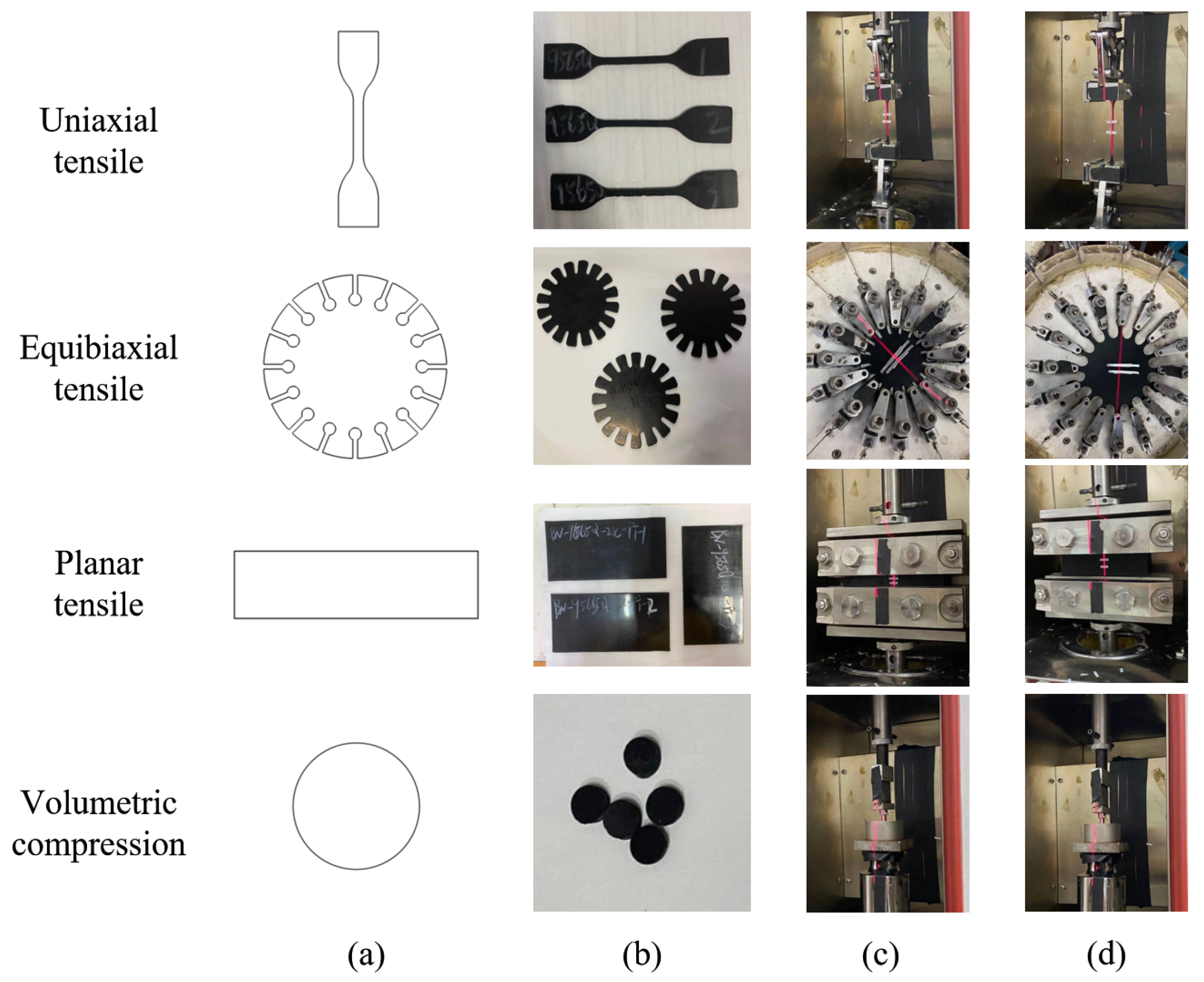
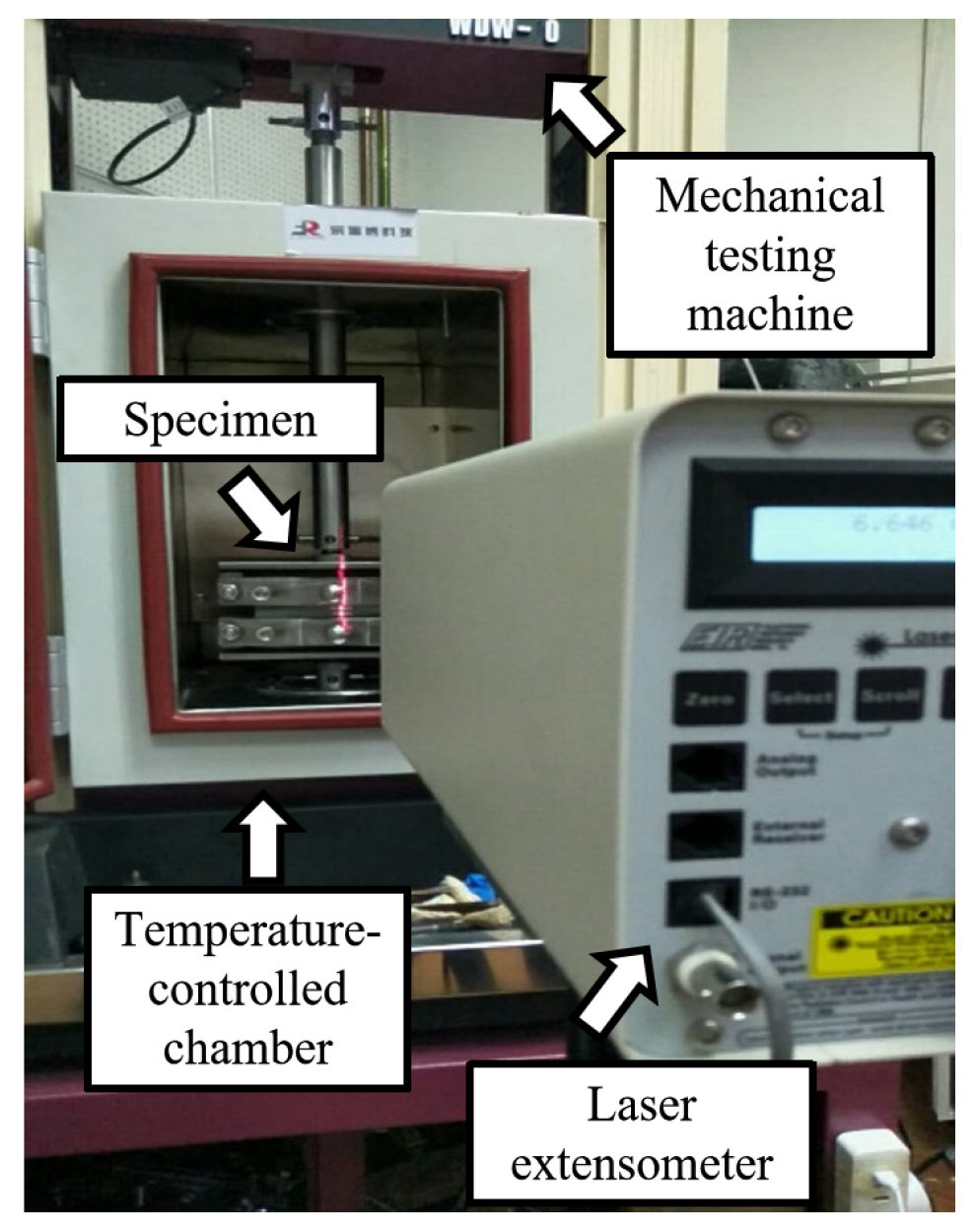

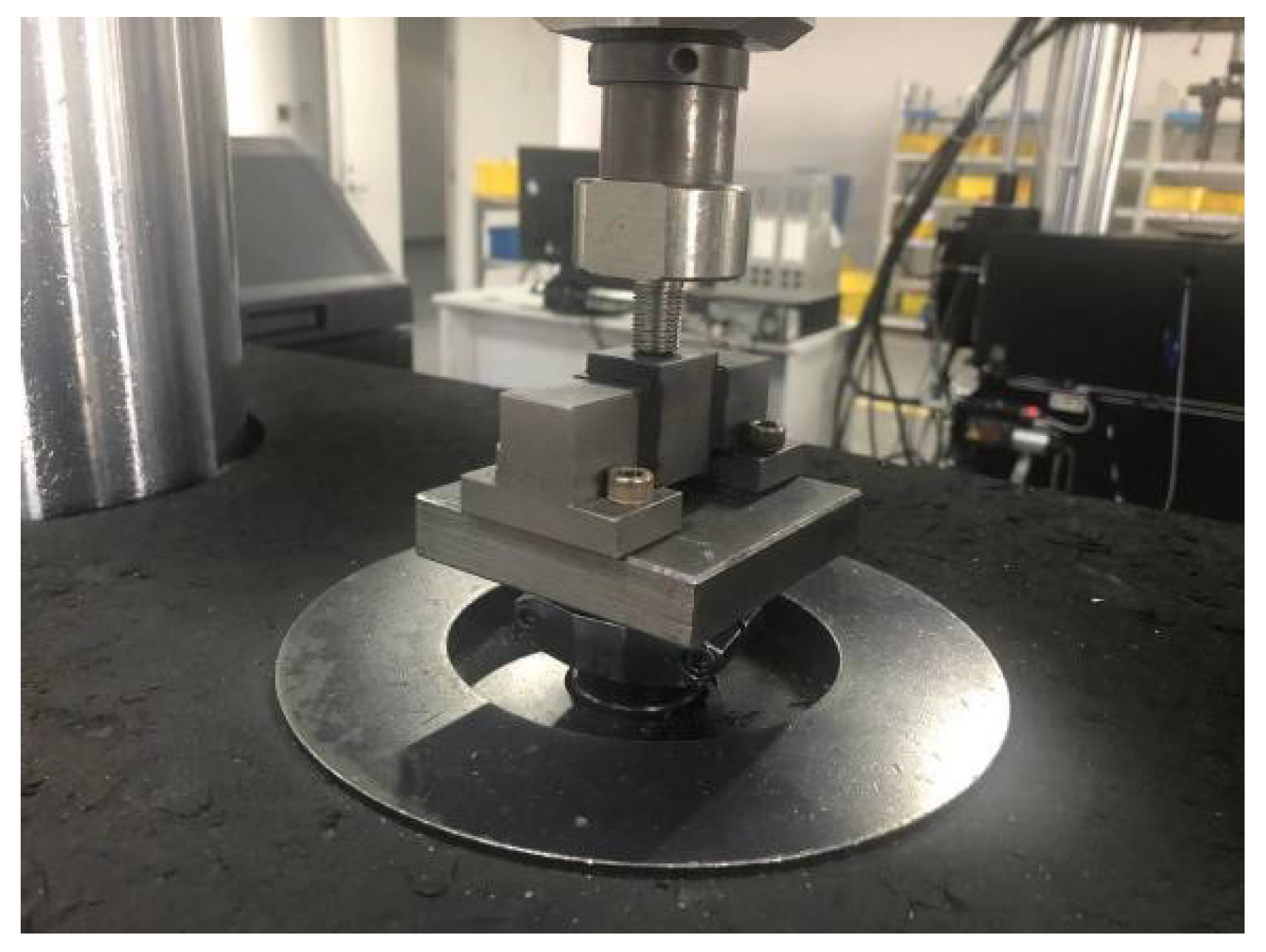


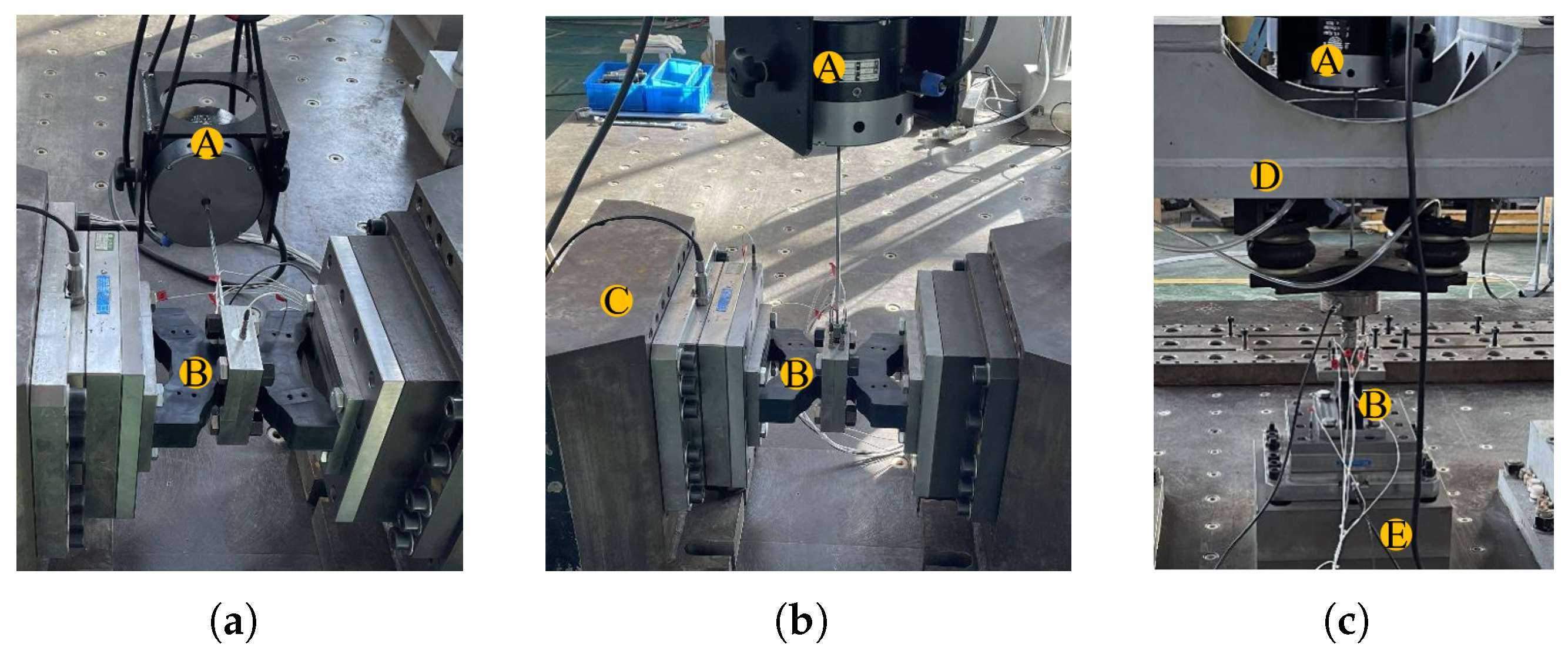

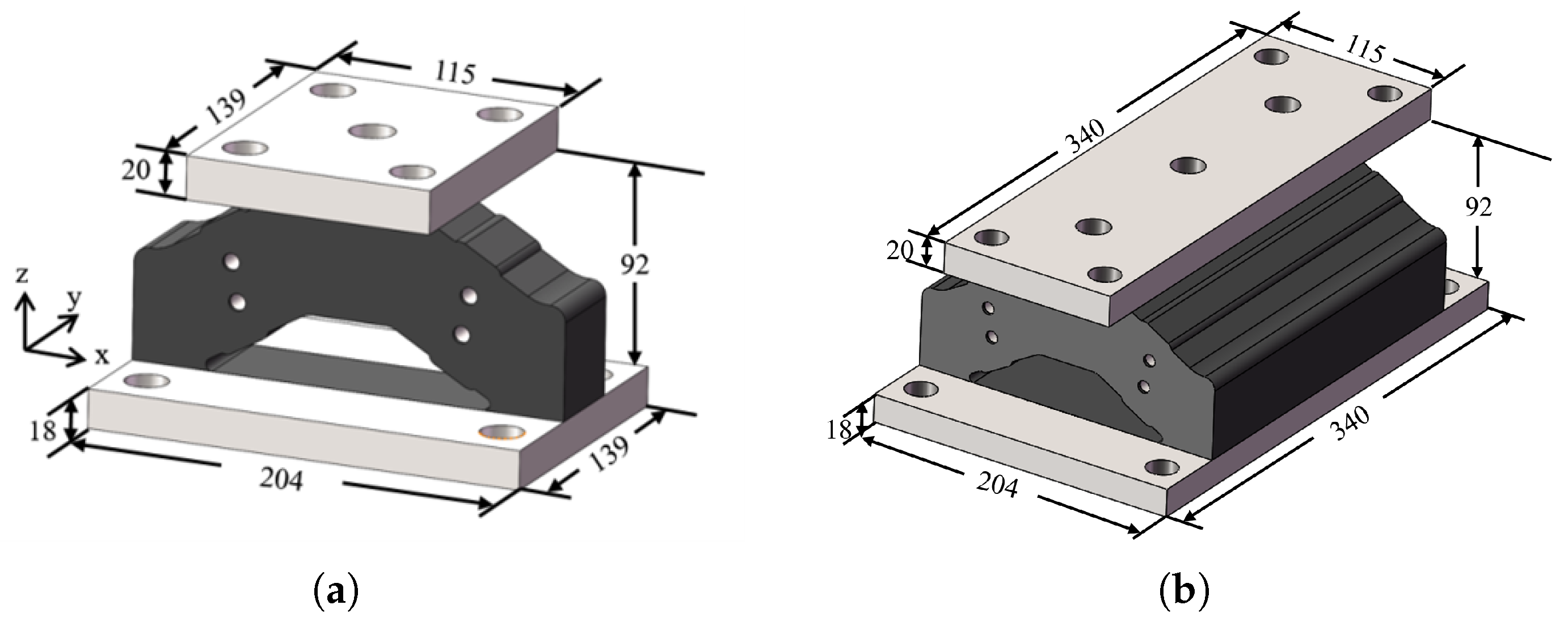
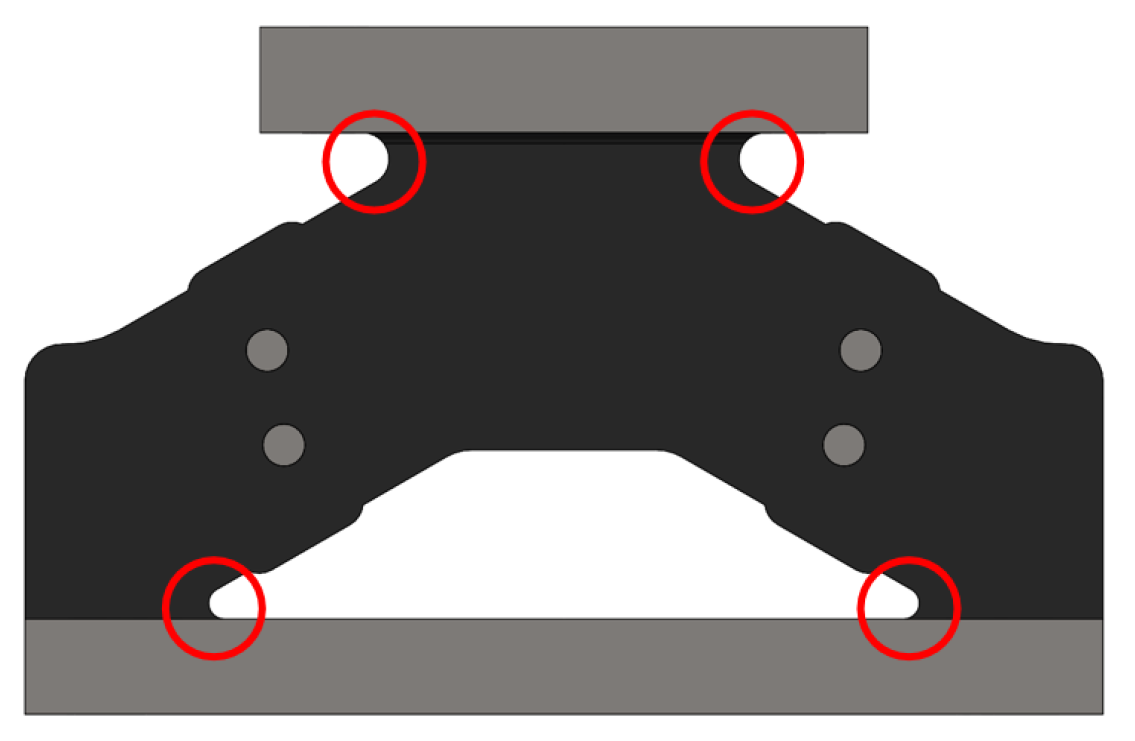


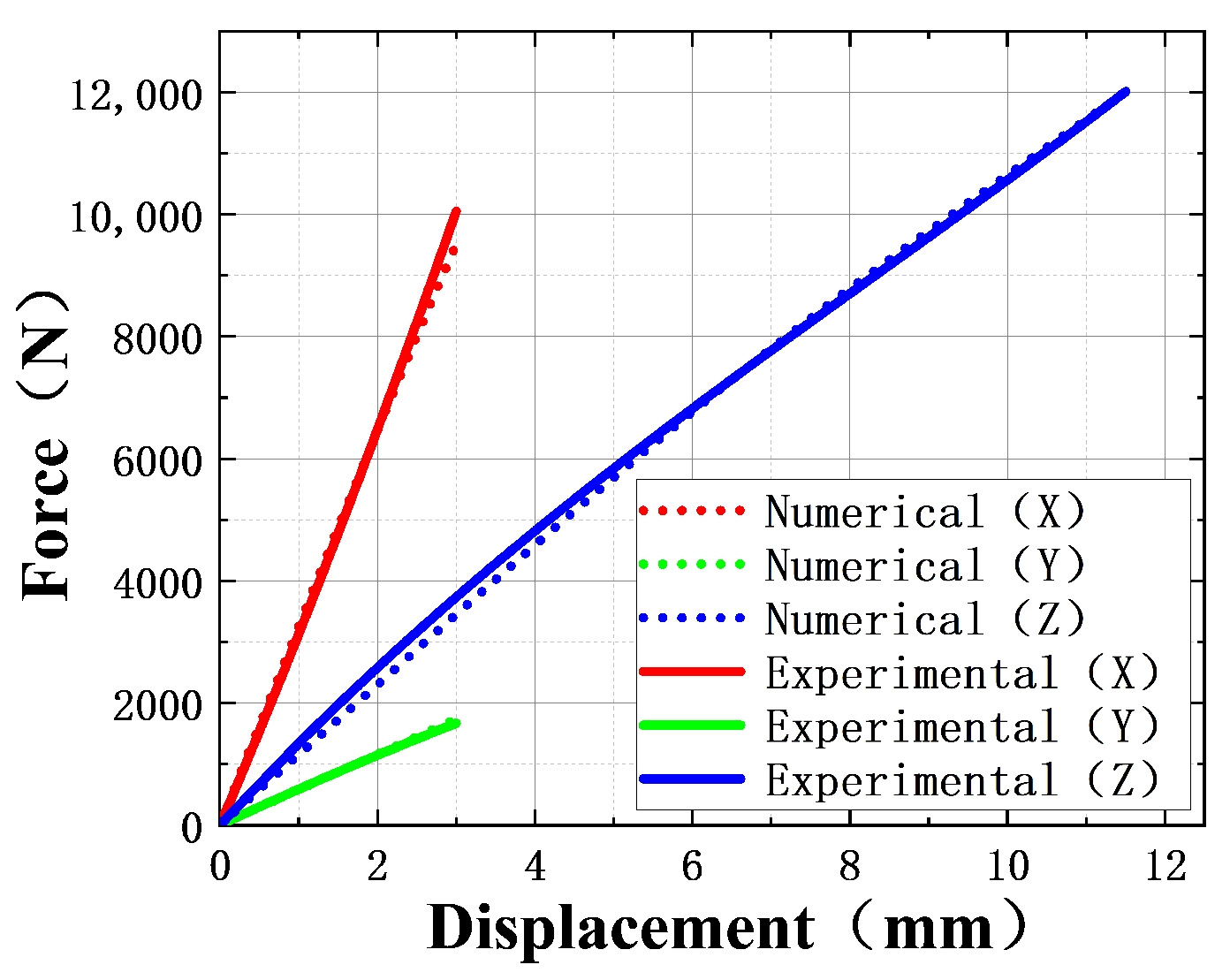

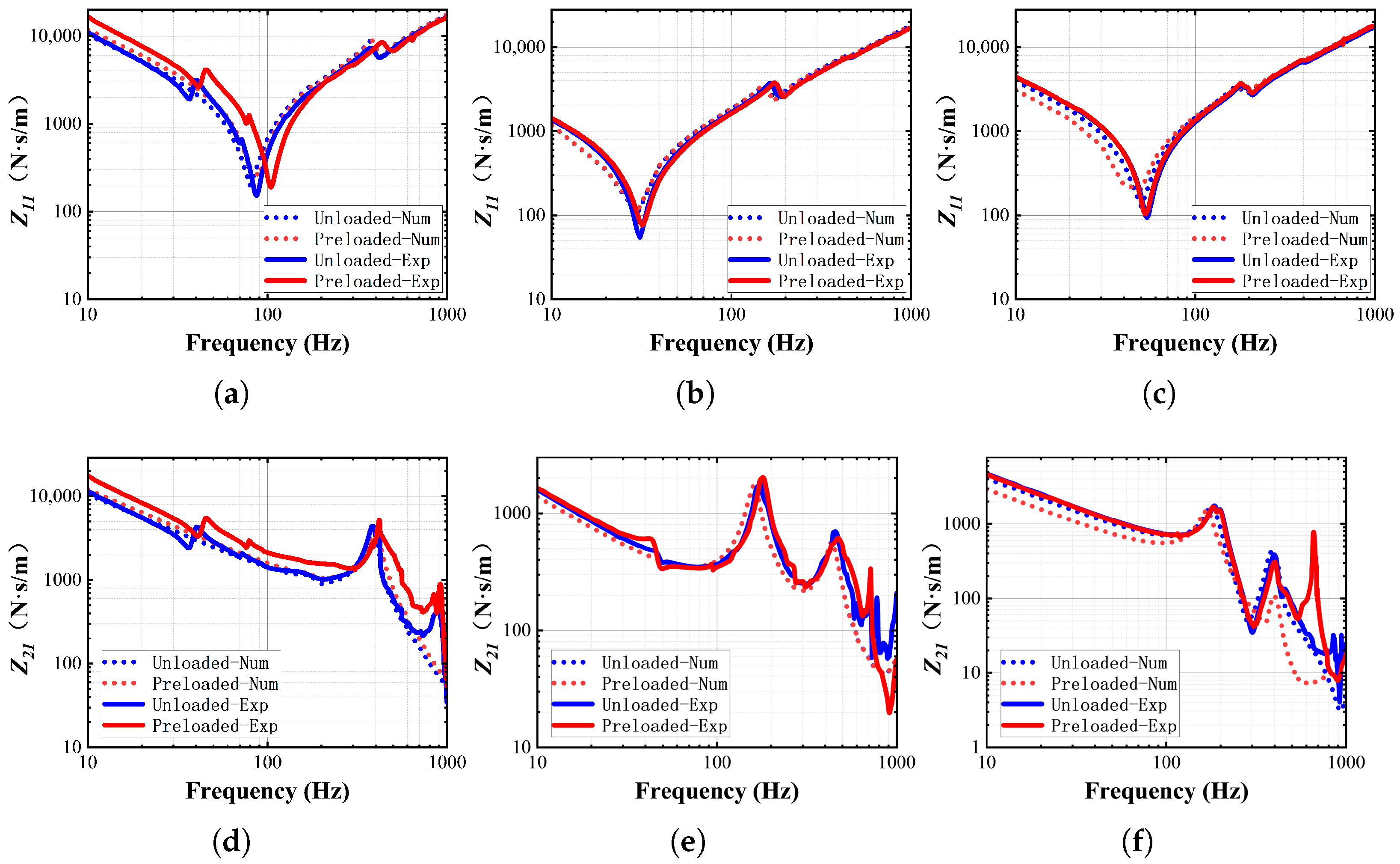



| Test Type | Number of Specimens | Specimen Size |
|---|---|---|
| Uniaxial tensile | 3 | ASTM D412 D type |
| Equibiaxial tensile | 3 | 60 mm × 2 mm |
| Planar tensile | 3 | 150 mm × 75 mm × 2 mm |
| Volumetric compression | 5 | 8 mm × 2 mm |
| Constitutive Models | Parameters |
|---|---|
| Mooney–Rivlin | |
| Neo–Hookean | |
| Yeoh | |
| 3rd Ogden |
| Device Name | Manufacturer | Model | Quantities |
|---|---|---|---|
| Accelerometers | PCB (Buffalo, NY, USA) | M52C68 | 6 |
| Impedance head | PCB (Buffalo, NY, USA) | 288D01 | 1 |
| Three-axis dynamic force plate | KISTLER (Winterthur, Switzerland) | 9255B | 1 |
| Dynamic force sensor | KISTLER (Winterthur, Switzerland) | 9341B | 1 |
| Electromagnetic excitation system | B&K (Nellum, Denmark) | 3625 | 1 |
| Data acquisition modules | NI (Austin, TX, USA) | 9234 | 2 |
| Isolator | Direction | ||||
|---|---|---|---|---|---|
| Unloaded | Preloaded | Unloaded | Preloaded | ||
| WH-150 | X | 99.82% | 97.71% | 98.57% | 95.38% |
| Y | 99.93% | 99.87% | 90.97% | 81.70% | |
| Z | 99.95% | 99.86% | 98.46% | 94.55% | |
| WH-1200 | X | 97.07% | 96.88% | 93.38% | 92.96% |
| Y | 99.36% | 99.42% | 96.37% | 96.23% | |
| Z | 99.81% | 99.82% | 94.97% | 85.62% | |
| Type | Direction | Unloaded Peak Frequency (Hz) | Preloaded Peak Frequency (Hz) |
|---|---|---|---|
| WH-150 | X | 380 | 400 |
| Y | 160,440 | 160,440 | |
| Z | 180,390 | 170,400 | |
| WH-1200 | X | 450 | 480 |
| Y | 170 | 170 | |
| Z | 170,450 | 160,480 |
Disclaimer/Publisher’s Note: The statements, opinions and data contained in all publications are solely those of the individual author(s) and contributor(s) and not of MDPI and/or the editor(s). MDPI and/or the editor(s) disclaim responsibility for any injury to people or property resulting from any ideas, methods, instructions or products referred to in the content. |
© 2024 by the authors. Licensee MDPI, Basel, Switzerland. This article is an open access article distributed under the terms and conditions of the Creative Commons Attribution (CC BY) license (https://creativecommons.org/licenses/by/4.0/).
Share and Cite
Zhang, B.; Zhao, Y.; You, J. Numerical and Experimental Study of Static and Dynamic Characteristics of Marine Shear-Compression Isolators. J. Mar. Sci. Eng. 2024, 12, 665. https://doi.org/10.3390/jmse12040665
Zhang B, Zhao Y, You J. Numerical and Experimental Study of Static and Dynamic Characteristics of Marine Shear-Compression Isolators. Journal of Marine Science and Engineering. 2024; 12(4):665. https://doi.org/10.3390/jmse12040665
Chicago/Turabian StyleZhang, Ben, Yinglong Zhao, and Jingyue You. 2024. "Numerical and Experimental Study of Static and Dynamic Characteristics of Marine Shear-Compression Isolators" Journal of Marine Science and Engineering 12, no. 4: 665. https://doi.org/10.3390/jmse12040665
APA StyleZhang, B., Zhao, Y., & You, J. (2024). Numerical and Experimental Study of Static and Dynamic Characteristics of Marine Shear-Compression Isolators. Journal of Marine Science and Engineering, 12(4), 665. https://doi.org/10.3390/jmse12040665







